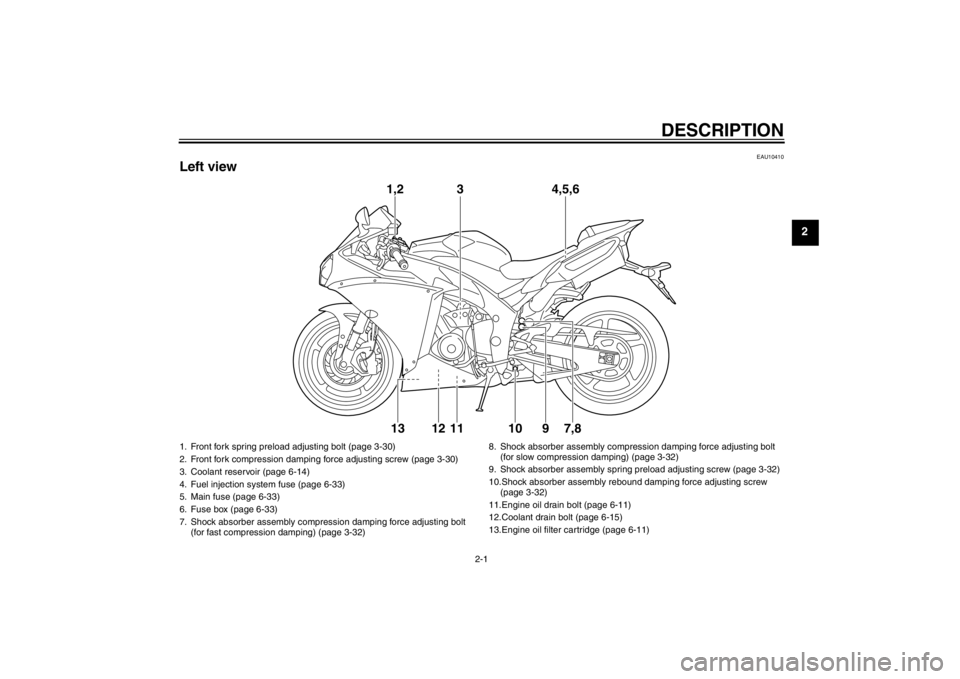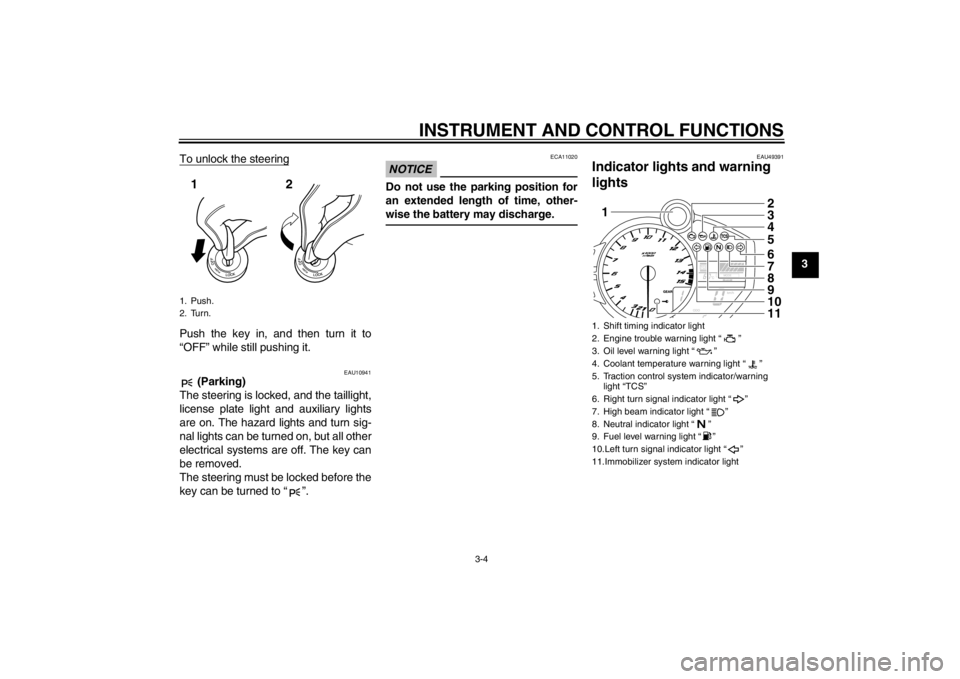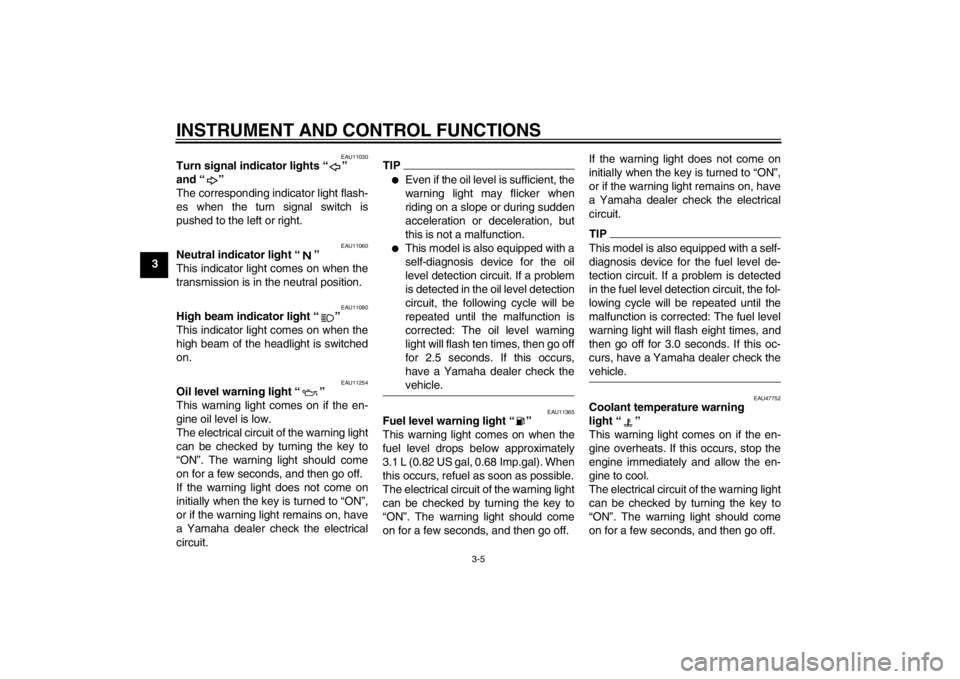engine coolant YAMAHA YZF-R1 2012 Owners Manual
[x] Cancel search | Manufacturer: YAMAHA, Model Year: 2012, Model line: YZF-R1, Model: YAMAHA YZF-R1 2012Pages: 112, PDF Size: 2.78 MB
Page 6 of 112

TABLE OF CONTENTSSAFETY INFORMATION ..................1-1
DESCRIPTION ..................................2-1
Left view ..........................................2-1
Right view ........................................2-2
Controls and instruments.................2-3
INSTRUMENT AND CONTROL
FUNCTIONS .......................................3-1
D-mode (drive mode) ......................3-1
Immobilizer system .........................3-1
Main switch/steering lock ................3-3
Indicator lights and warning lights ..............................3-4
Multi-function meter unit .................3-9
Anti-theft alarm (optional) .............3-18
Handlebar switches ......................3-18
Clutch lever ...................................3-20
Shift pedal .....................................3-20
Brake lever ...................................3-21
Brake pedal ..................................3-21
Traction control system ................3-22
Fuel tank cap ................................3-24
Fuel ...............................................3-25
Fuel tank breather hose and overflow hose ............................3-26
Catalytic converter ........................3-26
Seats ............................................3-27
Helmet holder ...............................3-28
Storage compartment ...................3-29
Rider footrest position ...................3-30 Rear view mirrors ......................... 3-30
Adjusting the front fork ................. 3-30
Adjusting the shock absorber
assembly ................................... 3-32
Luggage strap holders ................. 3-35
Sidestand ..................................... 3-35
Ignition circuit cut-off system ........ 3-36
FOR YOUR SAFETY –
PRE-OPERATION CHECKS ............. 4-1
OPERATION AND IMPORTANT
RIDING POINTS ................................. 5-1
Starting the engine ......................... 5-1
Shifting ........................................... 5-2
Tips for reducing fuel consumption ............................... 5-3
Engine break-in .............................. 5-3
Parking ........................................... 5-4
PERIODIC MAINTENANCE AND
ADJUSTMENT ................................... 6-1
Owner’s tool kit ............................... 6-2
Periodic maintenance chart for
the emission control system ....... 6-3
General maintenance and
lubrication chart .......................... 6-4
Removing and installing cowlings ...................................... 6-8
Checking the spark plugs ............. 6-10
Engine oil and oil filter cartridge ... 6-11 Coolant ........................................ 6-14
Air filter element ........................... 6-17
Checking the engine idling
speed ........................................ 6-17
Checking the throttle grip free
play ........................................... 6-18
Valve clearance ........................... 6-18
Tires ............................................. 6-18
Cast wheels ................................. 6-21
Adjusting the clutch lever free play ........................................... 6-21
Checking the brake lever free play ........................................... 6-22
Brake light switches ..................... 6-22
Checking the front and
rear brake pads ........................ 6-23
Checking the brake fluid level ...... 6-23
Changing the brake fluid .............. 6-25
Drive chain slack .......................... 6-25
Cleaning and lubricating
the drive chain .......................... 6-26
Checking and lubricating the cables ................................. 6-27
Checking and lubricating the throttle grip and cable ......... 6-27
Checking and lubricating
the brake and shift pedals ........ 6-28
Checking and lubricating the brake and clutch levers ...... 6-28
Checking and lubricating the sidestand ............................ 6-29U1KBE0E0.book Page 1 Monday, July 25, 2011 5:03 PM
Page 13 of 112

DESCRIPTION
2-1
2
EAU10410
Left view
1,2
3
4,5,6
13
12
11
10
7,8
9
1. Front fork spring preload adjusting bolt (page 3-30)
2. Front fork compression damping force adjusting screw (page 3-30)
3. Coolant reservoir (page 6-14)
4. Fuel injection system fuse (page 6-33)
5. Main fuse (page 6-33)
6. Fuse box (page 6-33)
7. Shock absorber assembly compression damping force adjusting bolt (for fast compression damping) (page 3-32) 8. Shock absorber assembly compression damping force adjusting bolt
(for slow compression damping) (page 3-32)
9. Shock absorber assembly spring preload adjusting screw (page 3-32)
10.Shock absorber assembly rebou nd damping force adjusting screw
(page 3-32)
11.Engine oil drain bolt (page 6-11)
12.Coolant drain bolt (page 6-15)
13.Engine oil filter cartridge (page 6-11)
U1KBE0E0.book Page 1 Monday, July 25, 2011 5:03 PM
Page 19 of 112

INSTRUMENT AND CONTROL FUNCTIONS
3-4
3
To unlock the steering
Push the key in, and then turn it to
“OFF” while still pushing it.
EAU10941
(Parking)
The steering is locked, and the taillight,
license plate light and auxiliary lights
are on. The hazard lights and turn sig-
nal lights can be turned on, but all other
electrical systems are off. The key can
be removed.
The steering must be locked before the
key can be turned to “ ”.
NOTICE
ECA11020
Do not use the parking position for
an extended length of time, other-
wise the battery may discharge.
EAU49391
Indicator lights and warning
lights
1. Push.
2. Turn.12
1. Shift timing indicator light
2. Engine trouble warning light “ ”
3. Oil level warning light “ ”
4. Coolant temperature warning light “ ”
5. Traction control system indicator/warning light “TCS”
6. Right turn signal indicator light “ ”
7. High beam indicator light “ ”
8. Neutral indicator light “ ”
9. Fuel level warning light “ ”
10.Left turn signal indicator light “ ”
11.Immobilizer system indicator light1 2
34561178910
U1KBE0E0.book Page 4 Monday, July 25, 2011 5:03 PM
Page 20 of 112

INSTRUMENT AND CONTROL FUNCTIONS
3-5
3
EAU11030
Turn signal indicator lights “ ”
and “ ”
The corresponding indicator light flash-
es when the turn signal switch is
pushed to the left or right.
EAU11060
Neutral indicator light “ ”
This indicator light comes on when the
transmission is in the neutral position.
EAU11080
High beam indicator light “ ”
This indicator light comes on when the
high beam of the headlight is switched
on.
EAU11254
Oil level warning light “ ”
This warning light comes on if the en-
gine oil level is low.
The electrical circuit of the warning light
can be checked by turning the key to
“ON”. The warning light should come
on for a few seconds, and then go off.
If the warning light does not come on
initially when the key is turned to “ON”,
or if the warning light remains on, have
a Yamaha dealer check the electrical
circuit.
TIP●
Even if the oil level is sufficient, the
warning light may flicker when
riding on a slope or during sudden
acceleration or deceleration, but
this is not a malfunction.
●
This model is also equipped with a
self-diagnosis device for the oil
level detection circuit. If a problem
is detected in the oil level detection
circuit, the following cycle will be
repeated until the malfunction is
corrected: The oil level warning
light will flash ten times, then go off
for 2.5 seconds. If this occurs,
have a Yamaha dealer check the
vehicle.
EAU11365
Fuel level warning light “ ”
This warning light comes on when the
fuel level drops below approximately
3.1 L (0.82 US gal, 0.68 Imp.gal). When
this occurs, refuel as soon as possible.
The electrical circuit of the warning light
can be checked by turning the key to
“ON”. The warning light should come
on for a few seconds, and then go off.If the warning light does not come on
initially when the key is turned to “ON”,
or if the warning light remains on, have
a Yamaha dealer check the electrical
circuit.
TIPThis model is also equipped with a self-
diagnosis device for the fuel level de-
tection circuit. If a problem is detected
in the fuel level detection circuit, the fol-
lowing cycle will be repeated until the
malfunction is corrected: The fuel level
warning light will flash eight times, and
then go off for 3.0 seconds. If this oc-
curs, have a Yamaha dealer check the
vehicle.
EAU47752
Coolant temperature warning
light “ ”
This warning light comes on if the en-
gine overheats. If this occurs, stop the
engine immediately and allow the en-
gine to cool.
The electrical circuit of the warning light
can be checked by turning the key to
“ON”. The warning light should come
on for a few seconds, and then go off.
U1KBE0E0.book Page 5 Monday, July 25, 2011 5:03 PM
Page 21 of 112

INSTRUMENT AND CONTROL FUNCTIONS
3-6
3
If the warning light does not come on
initially when the key is turned to “ON”,
or if the warning light remains on, have
a Yamaha dealer check the electrical
circuit.
NOTICE
ECA10021
Do not continue to operate the en-
gine if it is overheating.TIP●
For radiator-fan-equipped vehi-
cles, the radiator fan(s) automati-
cally switch on or off according to
the coolant temperature in the ra-
diator.
●
If the engine overheats, see page
6-40 for further instructions.
U1KBE0E0.book Page 6 Monday, July 25, 2011 5:03 PM
Page 22 of 112

INSTRUMENT AND CONTROL FUNCTIONS
3-7
3
DisplayConditionsWhat to do
Under 39 °C
(Under 103 °F) Message “Lo” is displayed. OK. Go ahead with riding.
40–116 °C
(104–242 °F) Coolant temperature is dis-
played.
OK. Go ahead with riding.
Above 117 °C
(Above 243 °F) Coolant temperature flashes.
Warning light comes on.Stop the vehicle and allow it to idle until
the coolant temperature goes down.
If the temperature does not go down,
stop the engine. (See page 6-40.)
U1KBE0E0.book Page 7 Monday, July 25, 2011 5:03 PM
Page 30 of 112

INSTRUMENT AND CONTROL FUNCTIONS
3-15
3
TIP●
Even if the air intake temperature
is set to be displayed, the coolant
temperature warning light comes
on if the engine overheats.
●
When the key is turned to “ON”,
the coolant temperature is auto-
matically displayed, even if the air
intake temperature was displayed
prior to turning the key to “OFF”.
●
When the air intake temperature
display is selected, “A” is displayed
before the temperature.
Traction control system mode dis-
playThis display indicates which traction
control system mode has been select-
ed. For more details on the modes and
on how to select them, refer to page
3-22.
Self-diagnosis device
This model is equipped with a self-diag-
nosis device for various electrical cir-
cuits.
If a problem is detected in the immobi-
lizer system circuits, the immobilizer
system indicator light flashes and the
display indicates an error code.
If a problem is detected in any other cir-
cuit, the engine trouble warning light
comes on and the display indicates an
error code.If the display indicates any error codes,
note the code number, and then have a
Yamaha dealer check the vehicle.
TIPIf the display indicates immobilizer sys-
tem circuit error code 52, this could be
caused by transponder interference. If
this error code appears, try following
the procedure below.1. Use the code re-registering key to start the engine.TIPMake sure there are no other immobi-
lizer keys close to the main switch, and
do not keep more than one immobilizer
key on the same key ring! Immobilizer
system keys may cause signal interfer-
ence, which may prevent the engine
from starting.2. If the engine starts, turn it off andtry starting the engine with the
standard keys.
3. If one or both of the standard keys do not start the engine, take the
vehicle, the code re-registering
1. Traction control system mode display
1
1. Error code display
1
U1KBE0E0.book Page 15 Monday, July 25, 2011 5:03 PM
Page 53 of 112

FOR YOUR SAFETY – PRE-OPERATION CHECKS
4-1
4
EAU15596
Inspect your vehicle each time you use it to make sure the vehicle is in safe operating condition. Always follow the inspection
and maintenance procedures and schedules described in the Owner’s Manual.
WARNING
EWA11151
Failure to inspect or maintain the vehicle properly increases the possibility of an accident or equipment damage.
Do not operate the vehicle if you find any problem. If a problem cannot be corrected by the procedures provided in
this manual, have the vehicle inspected by a Yamaha dealer.Before using this vehicle, check the following points:
ITEMCHECKS PAGE
Fuel Check fuel level in fuel tank.
Refuel if necessary.
Check fuel line for leakage.
Check fuel tank breather hose and overflow hose for obstructions, cracks or dam-
age, and check hose connections. 3-25, 3-26
Engine oil Check oil level in engine.
If necessary, add recommended oil to specified level.
Check vehicle for oil leakage. 6-11
Coolant Check coolant level in reservoir.
If necessary, add recommended coolant to specified level.
Check cooling system for leakage. 6-14
Front brake Check operation.
If soft or spongy, have Yamaha dealer bleed hydraulic system.
Check brake pads for wear.
Replace if necessary.
Check fluid level in reservoir.
If necessary, add specified brake fluid to specified level.
Check hydraulic system for leakage. 6-23, 6-23
U1KBE0E0.book Page 1 Monday, July 25, 2011 5:03 PM
Page 56 of 112

OPERATION AND IMPORTANT RIDING POINTS
5-1
5
EAU15951
Read the Owner’s Manual carefully to
become familiar with all controls. If
there is a control or function you do not
understand, ask your Yamaha dealer.
WARNING
EWA10271
Failure to familiarize yourself with
the controls can lead to loss of con-
trol, which could cause an accident
or injury.
EAU48710
TIPThis model is equipped with:●
a lean angle sensor to stop the en-
gine in case of a turnover. In this
case, the multi-function display in-
dicates error code 30, but this is
not a malfunction. Turn the key to
“OFF” and then to “ON” to clear the
error code. Failing to do so will pre-
vent the engine from starting even
though the engine will crank when
pushing the start switch.
●
an engine auto-stop system. The
engine stops automatically if left
idling for 20 minutes. If the engine
stops, simply push the start switch
to restart the engine.
EAU51880
Starting the engine In order for the ignition circuit cut-off
system to enable starting, one of the
following conditions must be met:●
The transmission is in the neutral
position.
●
The transmission is in gear with
the clutch lever pulled and the
sidestand up.
See page 3-36 for more informa-
tion.
1. Turn the key to “ON” and make sure that the engine stop switch is
set to “ ”.
The following warning lights and
indicator lights should come on for
a few seconds, then go off.●
Oil level warning light
●
Fuel level warning light
●
Coolant temperature warning
light
●
Shift timing indicator light
●
Engine trouble warning light
●
Traction control system indi-
cator/warning light
●
Immobilizer system indicator
light
U1KBE0E0.book Page 1 Monday, July 25, 2011 5:03 PM
Page 65 of 112

PERIODIC MAINTENANCE AND ADJUSTMENT
6-6
6
18 Sidestand Check operation.
Lubricate with lithium-soap-based
grease. √√√√√
19 *Sidestand switch Check operation. √√√√√√
20 *Front fork Check operation and for oil leak-
age. √√√√
21 *Shock absorber as-
sembly Check operation and shock ab-
sorber for oil leakage. √√√√
22 *Rear suspension re-
lay arm and con-
necting arm
pivoting points
Check operation.
√√√√
23 Engine oil Change.
Check oil level and vehicle for oil
leakage. √√√√√√
24 Engine oil filter car-
tridge Replace.
√√√
25 *Cooling system Check coolant level and vehicle
for coolant leakage. √√√√√
Change with ethylene glycol anti- freeze coolant. Every 3 years
26 *Front and rear brake
switches Check operation.
√√√√√√
27 Moving parts and
cables
Lubricate.
√√√√√
NO. ITEM CHECK OR MAINTENANCE JOB
ODOMETER READING
ANNUAL
CHECK
1000 km
(600 mi) 10000 km
(6000 mi) 20000 km
(12000 mi) 30000 km
(18000 mi) 40000 km
(24000 mi)
U1KBE0E0.book Page 6 Monday, July 25, 2011 5:03 PM